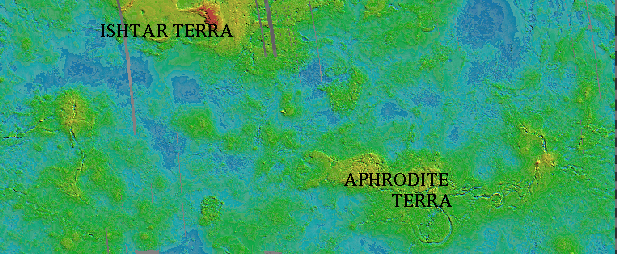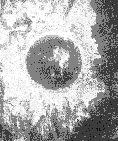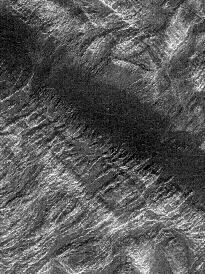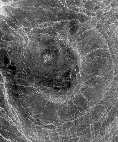
Above is a Mercator projection of Venus' surface. Most is the plain blue and green rolling plains, about 24% is highlands, such as Ishtar Terra and Aphrodite Terra, shown above. About 16% is volcanic peaks. Volcanism is clearly apparent on the surface. Like the Hawaiian islands, shield volcanos are seen on Venus's surface, created by highly fluid lava flows.

Impact Craters -->
Large impact craters with diameters a few to 280 km
are visible in the fractured plains. Smaller craters are not
found since smaller meteorites never make it to the ground.
Typical crater features seen: rough radar-bright ejecta surrounds
the perimeter of the craters; terraced inner walls; and large central peaks.
Crater floors appear dark because they are smooth, flooded
by lava.
There are nearly 1000 evenly spaced (surface is all the same age) craters
on Venus. The low number ages the current surface at 800 m.y.o.
With no weathering, global tectonics must be
capable of restoring the entire surface.
 <-- Large scale Tectonic Features
<-- Large scale Tectonic Features
Several tectonic events formed this complex terrain, which is part of the
interior of Ovda Regio. An underlying fabric of ridges and valleys are
spaced 10-20 km (6-12 mi) apart and may have been caused by
compression of the crust at right angles to the ridge. The largest valleys,
particularly the 20 km (12 mi) wide valley extending across the image,
were filled with dark material, probably lava. The complexity of Ovda
Regio attests to a long history of tectonic deformation.
 Corona -->
Corona -->
Located in Lada Terra, Selu Corona measures 350 km (210 mi) in diameter.
Coronae are circular to elliptical
features marked by a ring of concentric ridges, and are thought to result
from the flow of heat in the planet's
interior. As hot material rises, it weakens the upper layers of the crust,
causing the surface to dome upwards.
Then as the region cools, the dome begins to subside. As the upper
layers rise and fall, they are subjected to
stresses that crack the surface, creating both circular and radial
fractures.